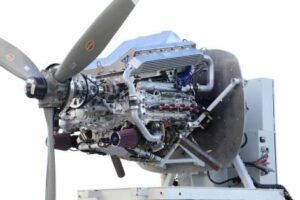Engineered Propulsion Systems (EPS) has announced details of their latest diesel aviation engine, the Graflight, which uniquely leverages the strength and stiffness of Compacted Graphite Iron (CGI), together with a ‘flat V’ engine design, to establish a new benchmark for general aviation applications.
Based on a CGI cylinder block, the 4.3 litre, eight-cylinder design results in a compact, low profile engine package that provides ease of installation, durability and low aerodynamic drag. The use of CGI enabled EPS to engineer a clean sheet Aviation Diesel engine that is setting new standards in weight, size, reliability, and most importantly, fuel consumption.
Initial testing of the pre-production engine has demonstrated specific power of 105 horsepower per litre (77 kW/l), resulting in an output of 450 horsepower (332 kW). The installed wet weight of the 450 horsepower diesel engine package is within 45 pounds (20 kg) of alternative 350 horsepower (257 kW) air-cooled turbocharged engines currently used in aero applications.
Heralded as the potential for a new era in aviation engines, the Graflight aero diesel promises to be more fuel efficient than any general aviation engine currently on the market. The diesel combustion process, together with the design freedom provided by high strength CGI coupled with steel pistons, enable EPS to realise 30-50% lower fuel consumption and emissions compared to conventional aero engines. Flying range and payload are also increased. With the prospect that avgas (leaded aviation gasoline) will be prohibited, the ability of the EPS engine to use widely available and low cost jet and diesel fuels provides a significant global growth opportunity.
Engine and flight tests are currently underway and EPS expects Federal Aviation Authority approvals during 2017. With series production awarded to the Grainger & Worrall foundry in the UK, using the SinterCast process control technology, the engine is intended for use in single and twin engined aircraft, small helicopters, unmanned military aircraft, and potentially marine applications.
“Building on our design experience with automotive diesel engines, we knew that Compacted Graphite Iron was the optimal material for the crankcase of our Graflight V8” said Mr Michael Fuchs, President of EPS. “The aero-engine industry has been relying on outdated engine technology and fuels for more than 20 years. Our use of modern technologies such as CGI, steel pistons, common rail fuel injection and electronic engine control form the basis of our competitive advantage, our contribution to the aviation industry, and our market opportunity. Our partnerships for the supply of critical components and technologies, with proven world class suppliers like Grainger & Worrall and SinterCast, are a key element of our ability to meet the necessarily stringent requirements set by the aviation authorities.”
Together, Mr Edward Grainger, Business Development Director at Grainger & Worrall and Dr Steve Dawson, President & CEO of SinterCast said: “we are pleased to contribute our experience from more than 10 years of joint CGI product development and the launch of more than 50 state-of-the-art CGI engine programmes to this exciting project, both for the development phase and for the future series production. The EPS engine provides a high profile application for CGI and further reinforces the benefits of CGI in demanding modern engine applications.”



















